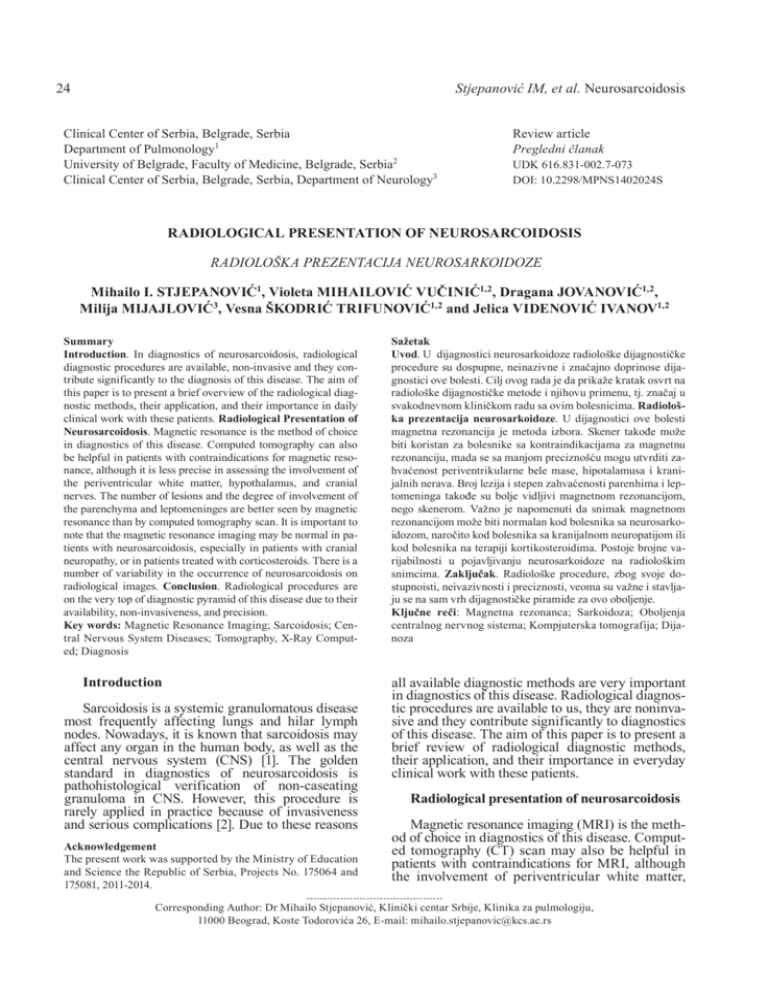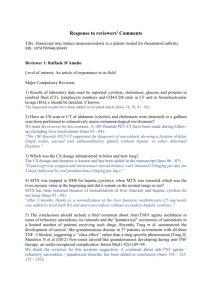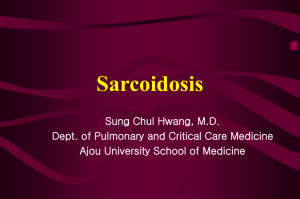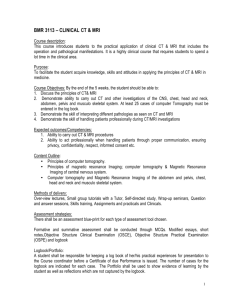Full text - doiSerbia
advertisement

Stjepanović IM, et al. Neurosarcoidosis 24 Clinical Center of Serbia, Belgrade, Serbia Department of Pulmonology1 University of Belgrade, Faculty of Medicine, Belgrade, Serbia2 Clinical Center of Serbia, Belgrade, Serbia, Department of Neurology3 Review article Pregledni članak UDK 616.831-002.7-073 DOI: 10.2298/MPNS1402024S RADIOLOGICAL PRESENTATION OF NEUROSARCOIDOSIS RADIOLOŠKA PREZENTACIJA NEUROSARKOIDOZE Mihailo I. STJEPANOVIĆ1, Violeta MIHAILOVIĆ VUČINIĆ1,2, Dragana JOVANOVIĆ1,2, Milija MIJAJLOVIĆ3, Vesna ŠKODRIĆ TRIFUNOVIĆ1,2 and Jelica VIDENOVIĆ IVANOV1,2 Summary Introduction. In diagnostics of neurosarcoidosis, radiological diagnostic procedures are available, non-invasive and they contribute significantly to the diagnosis of this disease. The aim of this paper is to present a brief overview of the radiological diagnostic methods, their application, and their importance in daily clinical work with these patients. Radiological Presentation of Neurosarcoidosis. Magnetic resonance is the method of choice in diagnostics of this disease. Computed tomography can also be helpful in patients with contraindications for magnetic resonance, although it is less precise in assessing the involvement of the periventricular white matter, hypothalamus, and cranial nerves. The number of lesions and the degree of involvement of the parenchyma and leptomeninges are better seen by magnetic resonance than by computed tomography scan. It is important to note that the magnetic resonance imaging may be normal in patients with neurosarcoidosis, especially in patients with cranial neuropathy, or in patients treated with corticosteroids. There is a number of variability in the occurrence of neurosarcoidosis on radiological images. Conclusion. Radiological procedures are on the very top of diagnostic pyramid of this disease due to their availability, non-invasiveness, and precision. Key words: Magnetic Resonance Imaging; Sarcoidosis; Central Nervous System Diseases; Tomography, X-Ray Computed; Diagnosis Introduction Sarcoidosis is a systemic granulomatous disease most frequently affecting lungs and hilar lymph nodes. Nowadays, it is known that sarcoidosis may affect any organ in the human body, as well as the central nervous system (CNS) [1]. The golden standard in diagnostics of neurosarcoidosis is pathohistological verification of non-caseating granuloma in CNS. However, this procedure is rarely applied in practice because of invasiveness and serious complications [2]. Due to these reasons Acknowledgement The present work was supported by the Ministry of Education and Science the Republic of Serbia, Projects No. 175064 and 175081, 2011-2014. Sažetak Uvod. U dijagnostici neurosarkoidoze radiološke dijagnostičke procedure su dospupne, neinazivne i značajno doprinose dijagnostici ove bolesti. Cilj ovog rada je da prikaže kratak osvrt na radiološke dijagnostičke metode i njihovu primenu, tj. značaj u svakodnevnom kliničkom radu sa ovim bolesnicima. Radiološka prezentacija neurosarkoidoze. U dijagnostici ove bolesti magnetna rezonancija je metoda izbora. Skener takođe može biti koristan za bolesnike sa kontraindikacijama za magnetnu rezonanciju, mada se sa manjom preciznošću mogu utvrditi zahvaćenost periventrikularne bele mase, hipotalamusa i kranijalnih nerava. Broj lezija i stepen zahvaćenosti parenhima i leptomeninga takođe su bolje vidljivi magnetnom rezonancijom, nego skenerom. Važno je napomenuti da snimak magnetnom rezonancijom može biti normalan kod bolesnika sa neurosarkoidozom, naročito kod bolesnika sa kranijalnom neuropatijom ili kod bolesnika na terapiji kortikosteroidima. Postoje brojne varijabilnosti u pojavljivanju neurosarkoidoze na radiološkim snimcima. Zaključak. Radiološke procedure, zbog svoje dostupnoisti, neivazivnosti i preciznosti, veoma su važne i stavljaju se na sam vrh dijagnostičke piramide za ovo oboljenje. Ključne reči: Magnetna rezonanca; Sarkoidoza; Oboljenja centralnog nervnog sistema; Kompjuterska tomografija; Dijanoza all available diagnostic methods are very important in diagnostics of this disease. Radiological diagnostic procedures are available to us, they are noninvasive and they contribute significantly to diagnostics of this disease. The aim of this paper is to present a brief review of radiological diagnostic methods, their application, and their importance in everyday clinical work with these patients. Radiological presentation of neurosarcoidosis Magnetic resonance imaging (MRI) is the method of choice in diagnostics of this disease. Computed tomography (CT) scan may also be helpful in patients with contraindications for MRI, although the involvement of periventricular white matter, Corresponding Author: Dr Mihailo Stjepanović, Klinički centar Srbije, Klinika za pulmologiju, 11000 Beograd, Koste Todorovića 26, E-mail: mihailo.stjepanovic@kcs.ac.rs Med Pregl 2014; LXVII (1-2): 24-27. Novi Sad: januar-februar. Abbreviations CNS – central nervous system MRI – magnetic resonance imaging TS – transcranial brain sonography CT – computed tomography scan PET – positron-emission tomography hypothalamus and cranial nerves can be assessed with less accuracy. The number of lesions and the degree of involvement of parenchyma and leptomeninges are also more visible by MRI than by CT scan. It is very important to mention that the recording of MRI may be normal in patients with neurosarcoidosis, especially in patients with cranial neuropathy or in patients treated by corticosteroids [3, 4]. There are numerous variabilities in the occurrence of neurosarcoidosis on radiological images. The involvement of leptomeninges, which involve arachnoid and soft brain membrane, is the most frequent finding on recordings, present in about 40 per cent of patients with neurosarcoidosis. On MRI and CT scan recordings with injected contrast, this can be seen as linear and nodular enlargement along the brain outlines, extending in cortical sulci covered with a layer of pia mater (soft brain membrane). Leptomeningeal disease is usually unperceivable on recordings without contrast. The involvement can be diffuse, focal or multifocal with predilection to basal ganglions. There is no difference in the appearance comparing to meningeal carcinomatosis, lymphoma, leukemia, tuberculosis and fungus meningitis [5, 6]. In basilar leptomeningeal disease, basilar middle structures, including hypothalamus and pituitary gland infundibulum are frequently involved. These structures or leptomeninges surrounding them can be involved. The involvement of these structures can be seen as thickening on the recordings with contrast. Sarcoidosis of pituitary gland infundibulum may be similar to lymphocytic hypophisitis, tuberculosis, histyocytosis, leukemia and metastasis [7]. Similarly, the cranial nerves may be involved, where the disease frequently penetrates into superficial leptomeninges and with possible secondary infiltrations. This can be noticed as a thickening and enlargement of cranial nerves on the recording with contrast. The recordings show a poor correlation between the cranial nerves involvement and clinically neurological deficiency. The involvement of the seventh nerve, i.e. facial nerve, most frequently has a clinical manifestation, while the optic nerve is most frequently involved on the recordings. Isolated involvement of cranial nerves may imitate neuritis of different etiology, including virus infections, as well as neoplasms such as schwannoma and glioma of optic nerve [7,8]. Leptomeningeal involvement may run along the leptomeningeal layer into the perivascular space (Virchow-Robin space) surrounding the entrant cerebral vessels. Infiltration in parenchyma may appear from any cerebral surface or Virchow- 25 Robin space, which finally connect and form granulomatous masses of different sizes. Intraparenchymal lesions are visible as perivascular enlarged lesions with or without an increase in T2 signal, with the increase reflecting the defect of brain blood barrier and the increase in T2 signal reflecting vasogenic edema due to the increased permeability. The enlargement is usually perceived as vertical in relation to the ventricles and cortical surfaces along the way of penetrating vessels. Lesions may rarely be presented as isolated enlargements of parenchymal tumefactive mass that may imitate neoplasms [9, 10]. Dura involvement is less frequently perceived than leptomeninges involvement. Dural lesions may look like enlargement of dural thickening, plaques or discrete masses and they can be seen on noncontrast recording, but not necessarily. When noticed, these changes are usually isointense with grey mass on T1 sequences of MRI and hypointense on T2 sequences of MRI. The end of dura can be seen as an intensified thickening extending from the basic mass, and the central classification can also be present. As in meningeoma, the dura and leptomeninges involvement does not normally appear together, and it is believed that arachnoid cells in the part of arachnoid mass can prevent inflammation from spreading. From the differentially diagnostic point of view, considerations of dural lesions include meningiomas, metastases, plasmacytoma, granulomatous infections, etc. [11]. Diffuse or focal area of T2 signal occurrence without increased intensity may be observed in the periventricular white mass, rarely in the cerebral stem and basal ganglions. These lesions are nonspecific and they resemble lesions likely to be seen in multiple sclerosis, vasculitis, microvascular disease and infectious disease such as Lyme disease (Figure 1). These lesions are not normally correlated with clinical symptoms and they do not generally go away with treatment [12]. Figure 1. MRI - supratentorial multiple microangiopathic lesions, and cortical brain reductive changes Slika 1. MRI – supratentorijalne multipne mikroangiopatske lezije i reduktivne promene na korteksu mozga 26 Figure 2. CNS CT scan - acute unilateral hydrocephalus with enlargement of the right lateral ventricle and periventricular lower density Slika 2. CNS CT sken – akutni unilateralni hidrocefalus sa uvećanom desnom bočnom komorom i periventrikularnom manjom gustinom Communicating or noncommunicating hydrocephalus is relatively rare in these patients. Communicating hydrocephalus may be secondary in leptomeninges or dura involvement with abnormal resorption of cerebral-spinal liquid. Noncommunicating or obstructive hydrocephalus may be secondary in granulomatous compression or adhesions in the ventricular system, usually in the cerebral aquaduct and in the fourth ventricle, i.e. foramen (Megendie and Lushka foramine) (Figure 2) [3]. Neurosarcoidosis may also affect the spinal cord and it may appear as an isolated finding or related to intracranial diseases. The most frequent manifestation is leptomeningeal involvement, perceivable as a linear and nodular thickening along the surface of the spinal cord and nerves root. In 0.3 to 0.4 per cent of patients with sarcoidosis, the intramedular part of spinal cord may be affected, which can be observed on the recordings as an intensification of T2 signal, T1 signal decrease with partial contrast injecting. Similarly to the brain, the intramedular involvement is considered to be secondary in centripetal extension of leptomeningeal disease via perivascular Virchow-Robin space. These lesions may later appear simultaneously. The lesions caused by neurosarcoidosis may affect any part of the spinal cord, but they most frequently affect its cervical part. From the differentially diagnostic point of view, considerations of intramedular lesions include neoplasms, multiple sclerosis, optic neuromielitis and tuberculosis. Radiological prog­ress may not keep abreast with clinical improvement and there also may be improvement on recordings with the presence or progression of clinical symptoms. Spinal cord atrophy frequently appears, especially in patients with late diagnosis [13]. Stjepanović IM, et al. Neurosarcoidosis Positron-emission tomography (PET) is another radiological diagnostic procedure that can be applied in these patients. It must be mentioned that PET is limited to a certain degree in assessment of lesions in CNS because it can show accelerated or delayed metabolism. Accelerated metabolism in CNS is secondary in sarcoid inflammation. Delayed metabolism, on the other hand, is considered to be secondary in neuron dysfunction, where metabolic demand is decreased in affected areas in relation to high metabolic needs of the brain. In spite of limitations, PET may reveal the lesions of CNS in patients with no suspicion of sarcoidosis and it may be useful in observation of therapy reactions [14, 15]. PET imaging and scanning with gallium -67 may be useful in diagnostics of sarcoidosis, by indicating the presence of a systemic disease and identifying accessible lymph nodes for biopsy. They can also be applied to assess sarcoidosis activity and degree of involvement. PET visualization is very susceptible to increased metabolic activities of lymphoid tissues appearing in sarcoidosis, but it is nonspecific, with a wide range of different possible diagnoses including lymphoma, metastases and infections. Scanning of the whole body with gallium is less susceptible and it is specific for diagnostics of sarcoidosis, so only two of three patients have a positive gallium scan [16, 17]. When the disease involves skeletal muscles, magnetic resonance imaging and PET scan are particularly significant. In the series of Tiersen et al. including 137 patients with sarcoidosis, 6 patients were described by using 18-Fluoro-deoxyglucose (FDG) PET scan of the complete body [18]. Transcranial brain sonography (TS) is another noninvasive method used lately for diagnostic purposes in patients with sarcoidosis. TS in B-mode is capable of visualization of infratentorial and supratentorial cerebral structures. This method is widely applied in patients with Parkison’s disease. The most recent research deals with the application of this ultrasound method in measuring and detection of hypoechogenicity of the substantia nigra and hyperechogenicity of nucleus ruber in patients with neurosarcoidosis. These findings are in correlation with the level of tiredness, depression, anxiety and movement disorder (”restless legs syndrome”), frequently noticed in these patients. By revealing structural changes in brain parenchyma by this method adequate therapy modality can be reached in the patients with this disease [19, 20]. Conclusion Since it is very difficult to make pathohistological diagnosis of neurosarcoidosis, radiological diagnostics is very important in making diagnosis as fast and optimal as possible. Radiological procedures give significant contribution to the diagnostics of this disease and they are on the very top of diagnostic pyramid of this disease due to their availability, non-invasiveness, and precision. Med Pregl 2014; LXVII (1-2): 24-27. Novi Sad: januar-februar. 27 References 1. Škodrić-Trifunović V, Vučinić V, Simić-Ogrizović S, Stević R, Stjepanović M, Ilić K, et al. Mystery called sarcoidosis: forty four years follow up of chronic systemic disease. Srp Arh Celok Lek 2012;140(11-12):768-71. 2. Stjepanović M, Jovanović D, Dudvarski-Ilić A, MihailovićVučinić V, Škodrić-Trifunović V, Popević S. Kliničke manifestacije neurosarkoidoze. Med Pregl 2013;65(Suppl 1):54-9. 3. Shah R, Roberson GH, Curé JK. Correlation of MR imaging findings and clinical manifestations in neurosarcoidosis. AJNR Am J Neuroradiol 2009;30(5):935-61. 4. Pawate S, Moses H, Sriram S. Presentations and outcome of neurosarcoidosis: a study of 54 cases. QJM 2009;102(7):449-60. 5. Lury KM, Smith JK, Matheus MG, Castillo M. Neurosarcoidosis: review of imaging findings. Semin Roentgenol 2004;39(4):495-504. 6. Koyama T, Ueda H, Togashi K, Umeoka S, Kataoka M, Nagai S. Radiologic manifestations of sarcoidosis in various organs. Radiographics 2004;24(1):87-104. 7. Nowak DA, Widenka DC. Neurosarcoidosis: a review of its intracranial manifestation. J Neurol 2001;248:363-72. 8. Sherman JL, Stern BJ. Sarcoidosis of tne CNS: comparison of unenhanced and enhanced MR images. Am J Roentgenol 1990;155:1293-301. 9. Stjepanović M. Vanplućne komplikacije plućne sarkoidoze-neurosarkoidoza: evaluacija, terapija i komplikacije zahvaćenosti nervnog sistema (specijalistički rad). Beograd: Medicinski fakultet; 2013. 10. Pickuth D, Spielmann RP, Heywang-Köbrunner SH. Role of radiology in the diagnosis of neurosarcoidosis. Eur Radiol 2000;10(6):941-4. 11. Wilson JD, Castillo M, Van Tassel P. MRI features of intracranial sarcoidosis mimicking meningiomas. Clin Imaging 1994;18:184-8. 12. Dumas JL, Valeyre D, Chapelon-Abric C, Belin C, Piette JC, Tandjaoui-Lambiotte H, et al. Central nervous system Rad je primljen 27. X 2013. Recenziran 8. XII 2013. Prihvaćen za štampu 18. XII 2013. BIBLID.0025-8105:(2014):LXVII:1-2:24-27. sarcoidosis: follow-up at MR imaging during steroid therapy. Radiology 2000;214(2):411-20. 13. Koike H, Misu K, Yasui K, Kameyama T, Ando T, Yanagi T, et al. Differential response to corticosteroid therapy of MRI findings and clinical manifestations in spinal cord sarcoidosis. J Neurol 2000;247(7):544-9. 14. Aide N, Benayoun M, KeRrou K, Khalil A, Cadranel J, Talbot JN. Impact of 18F-fluorodeoxyglucose (18F-FDG) imaging in sarcoidosis: unsuspected neurosarcoidosis discovered by [18F]-FDG PET and early metabolic response to corticosteroid therapy. Br J Radiol 2007;80(951):e67-71. 15. Videnović-Ivanov J, Šobić-Šaranović D, Grozdić I, Mihailović-Vučinić V, Filipović S, Stjepanović M. Rezultati primene 18F-FDG/PET scan-a kod sarkoidoze hroničnog toka. Med Pregl 2013;65(Suppl 1):50-3. 16. Dubey N, Miletich RS, Wasay M, Mechtler LL, Bakshi R. Role of fluorodeoxyglucose positron emission tomography in the diagnosis of neurosarcoidosis. J Neurol Sci 2002;205:77-81. 17. Mana J. Magnetic resonance imaging and nuclear imaging in sarcoidosis. Curr Opin Pulm Med 2002;8:457-63. 18. Teirstein AS, Machac J, Almeida O, Lu P, Padilla ML, Iannuzzi MC. Results of 188 whole-body fluorodeoxyglucose positron emission tomography scans in 137 patients with sarcoidosis. Chest 2007;132(6):1949-53. 19. Vučinić V, Sternić N, Mijailović M, Vuković M, Videnović J, Omčikus M, et al. Transcranial sonography (TCS) in sarcoidosis-the relation between sleep discorders, restless legs syndrome, fatigue, depression and anxiety [abstract]. Chest 2011;140(4):623A. 20. Mijajlovic M, Vucinic V, Sternic N, Videnovic J, Stjepanovic M, Omcikus M, et al. Transcranial brain sonography findings in neurosaroidosis [abstract]. Cerebrovasc Dis 2013;35(Suppl 2):59-60.







